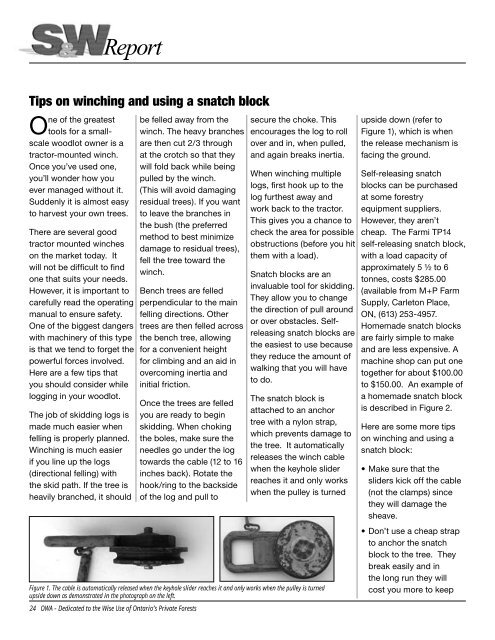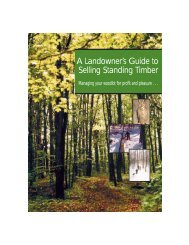Tips on winching and using a snatch block - Ontario woodlot.com
Tips on winching and using a snatch block - Ontario woodlot.com
Tips on winching and using a snatch block - Ontario woodlot.com
Create successful ePaper yourself
Turn your PDF publications into a flip-book with our unique Google optimized e-Paper software.
<str<strong>on</strong>g>Tips</str<strong>on</strong>g> <strong>on</strong> <strong>winching</strong> <strong>and</strong> <strong>using</strong> a <strong>snatch</strong> <strong>block</strong><br />
One of the greatest<br />
tools for a smallscale<br />
<strong>woodlot</strong> owner is a<br />
tractor-mounted winch.<br />
Once you’ve used <strong>on</strong>e,<br />
you’ll w<strong>on</strong>der how you<br />
ever managed without it.<br />
Suddenly it is almost easy<br />
to harvest your own trees.<br />
There are several good<br />
tractor mounted winches<br />
<strong>on</strong> the market today. It<br />
will not be difficult to find<br />
<strong>on</strong>e that suits your needs.<br />
However, it is important to<br />
carefully read the operating<br />
manual to ensure safety.<br />
One of the biggest dangers<br />
with machinery of this type<br />
is that we tend to forget the<br />
powerful forces involved.<br />
Here are a few tips that<br />
you should c<strong>on</strong>sider while<br />
logging in your <strong>woodlot</strong>.<br />
The job of skidding logs is<br />
made much easier when<br />
felling is properly planned.<br />
Winching is much easier<br />
if you line up the logs<br />
(directi<strong>on</strong>al felling) with<br />
the skid path. If the tree is<br />
heavily branched, it should<br />
24 OWA - Dedicated to the Wise Use of <strong>Ontario</strong>’s Private Forests<br />
be felled away from the<br />
winch. The heavy branches<br />
are then cut 2/3 through<br />
at the crotch so that they<br />
will fold back while being<br />
pulled by the winch.<br />
(This will avoid damaging<br />
residual trees). If you want<br />
to leave the branches in<br />
the bush (the preferred<br />
method to best minimize<br />
damage to residual trees),<br />
fell the tree toward the<br />
winch.<br />
Bench trees are felled<br />
perpendicular to the main<br />
felling directi<strong>on</strong>s. Other<br />
trees are then felled across<br />
the bench tree, allowing<br />
for a c<strong>on</strong>venient height<br />
for climbing <strong>and</strong> an aid in<br />
over<strong>com</strong>ing inertia <strong>and</strong><br />
initial fricti<strong>on</strong>.<br />
Once the trees are felled<br />
you are ready to begin<br />
skidding. When choking<br />
the boles, make sure the<br />
needles go under the log<br />
towards the cable (12 to 16<br />
inches back). Rotate the<br />
hook/ring to the backside<br />
of the log <strong>and</strong> pull to<br />
Figure 1. The cable is automatically released when the keyhole slider reaches it <strong>and</strong> <strong>on</strong>ly works when the pulley is turned<br />
upside down as dem<strong>on</strong>strated in the photograph <strong>on</strong> the left.<br />
secure the choke. This<br />
encourages the log to roll<br />
over <strong>and</strong> in, when pulled,<br />
<strong>and</strong> again breaks inertia.<br />
When <strong>winching</strong> multiple<br />
logs, first hook up to the<br />
log furthest away <strong>and</strong><br />
work back to the tractor.<br />
This gives you a chance to<br />
check the area for possible<br />
obstructi<strong>on</strong>s (before you hit<br />
them with a load).<br />
Snatch <strong>block</strong>s are an<br />
invaluable tool for skidding.<br />
They allow you to change<br />
the directi<strong>on</strong> of pull around<br />
or over obstacles. Selfreleasing<br />
<strong>snatch</strong> <strong>block</strong>s are<br />
the easiest to use because<br />
they reduce the amount of<br />
walking that you will have<br />
to do.<br />
The <strong>snatch</strong> <strong>block</strong> is<br />
attached to an anchor<br />
tree with a nyl<strong>on</strong> strap,<br />
which prevents damage to<br />
the tree. It automatically<br />
releases the winch cable<br />
when the keyhole slider<br />
reaches it <strong>and</strong> <strong>on</strong>ly works<br />
when the pulley is turned<br />
upside down (refer to<br />
Figure 1), which is when<br />
the release mechanism is<br />
facing the ground.<br />
Self-releasing <strong>snatch</strong><br />
<strong>block</strong>s can be purchased<br />
at some forestry<br />
equipment suppliers.<br />
However, they aren’t<br />
cheap. The Farmi TP14<br />
self-releasing <strong>snatch</strong> <strong>block</strong>,<br />
with a load capacity of<br />
approximately 5 ½ to 6<br />
t<strong>on</strong>nes, costs $285.00<br />
(available from M+P Farm<br />
Supply, Carlet<strong>on</strong> Place,<br />
ON, (613) 253-4957.<br />
Homemade <strong>snatch</strong> <strong>block</strong>s<br />
are fairly simple to make<br />
<strong>and</strong> are less expensive. A<br />
machine shop can put <strong>on</strong>e<br />
together for about $100.00<br />
to $150.00. An example of<br />
a homemade <strong>snatch</strong> <strong>block</strong><br />
is described in Figure 2.<br />
Here are some more tips<br />
<strong>on</strong> <strong>winching</strong> <strong>and</strong> <strong>using</strong> a<br />
<strong>snatch</strong> <strong>block</strong>:<br />
• Make sure that the<br />
sliders kick off the cable<br />
(not the clamps) since<br />
they will damage the<br />
sheave.<br />
• D<strong>on</strong>’t use a cheap strap<br />
to anchor the <strong>snatch</strong><br />
<strong>block</strong> to the tree. They<br />
break easily <strong>and</strong> in<br />
the l<strong>on</strong>g run they will<br />
cost you more to keep
eplacing them. Use<br />
a good quality strap<br />
that is a minimum of 3<br />
inches wide, <strong>and</strong> keep<br />
in mind that the safe<br />
working load is greatly<br />
reduced when the<br />
strap is used choker<br />
style (i.e., anchoring<br />
the <strong>snatch</strong> <strong>block</strong> to a<br />
tree). For example, <strong>on</strong>e<br />
manufacturer lists the<br />
safe working load of their<br />
polyester sling at 12,800<br />
lbs. <strong>and</strong> that it is reduced<br />
to 4,800 lbs. when used<br />
choker style.<br />
• Another opti<strong>on</strong> to<br />
c<strong>on</strong>sider (instead of<br />
<strong>using</strong> a nyl<strong>on</strong> strap) is to<br />
attach the <strong>snatch</strong> <strong>block</strong><br />
to the tree <strong>using</strong> a Kevlar<br />
rope (i.e., a ½-inch Kevlar<br />
rope, tied in a figure 8<br />
loop or bowline <strong>on</strong> either<br />
end).<br />
• The <strong>snatch</strong> <strong>block</strong> should<br />
always be anchored to<br />
a healthy tree (i.e., no<br />
dead branches), have a<br />
minimum diameter of 8<br />
inches, <strong>and</strong> be located<br />
opposite the skid trail.<br />
• When positi<strong>on</strong>ing your<br />
tractor (winch) <strong>and</strong><br />
determining your line of<br />
pull, make sure you do<br />
not double back! If you<br />
do, you will be doubling<br />
the stress <strong>on</strong> everything<br />
(i.e., <strong>snatch</strong> <strong>block</strong>,<br />
anchor strap, <strong>and</strong> cable)<br />
except the winch.<br />
• Winching at an angle<br />
greater then 30 degrees<br />
(to your line of pull) may<br />
cause your machine<br />
to tip. Either repositi<strong>on</strong><br />
your equipment or use a<br />
<strong>snatch</strong> <strong>block</strong> to prevent<br />
this unsafe operating<br />
c<strong>on</strong>diti<strong>on</strong>.<br />
• If you need to implement<br />
a minor change in<br />
directi<strong>on</strong> to the pull, just<br />
choke the keyhole slider<br />
to a stump <strong>using</strong> a chain.<br />
Do not try to change the<br />
directi<strong>on</strong> more than 15<br />
degrees. This method is<br />
for occasi<strong>on</strong>al use. (If it is<br />
d<strong>on</strong>e too often, the cable<br />
will be cut by the slider<br />
yoke).<br />
If you notice that you<br />
are going through a lot<br />
of gloves while h<strong>and</strong>ling<br />
the winch cable, the<br />
cable is beginning to<br />
fray. Remember that it is<br />
<strong>on</strong>ly the last 10-20 feet<br />
that take the majority of<br />
the abuse. To solve this<br />
problem, simply reverse<br />
the cable as follows:<br />
• Pay attenti<strong>on</strong> to the<br />
directi<strong>on</strong> the cable<br />
<strong>com</strong>es off of the drum<br />
because it must be<br />
C<strong>on</strong>tinued next page ...<br />
Figure 2. The following photographs <strong>and</strong> text<br />
provides details <strong>on</strong> how to c<strong>on</strong>struct a selfreleasing<br />
<strong>snatch</strong> <strong>block</strong>, something that can be<br />
made up at a local machine shop.<br />
1. Sheave – machined 5 inch<br />
(outside diameter) by 4½<br />
inch (inside diameter) sheave<br />
with a 1½ bored centre (to<br />
ac<strong>com</strong>modate the brass<br />
bushing insert). The ½-inch<br />
groove ac<strong>com</strong>modates 3 /8 -inch<br />
cable.<br />
2. Brass bushing – machined 1½- inch (diameter)<br />
brass bushing with a 1-inch bored centre (to<br />
ac<strong>com</strong>modate the 1- inch steel stock).<br />
3. Steel stock – 1 inch (diameter) by 2 inches (length)<br />
steel stock with a 3 /8 - inch bored centre with <strong>on</strong>e<br />
end threaded (½ inch) to ac<strong>com</strong>modate a 3 /8 -inch<br />
bolt. The round steel stock is inserted into the steel<br />
plate <strong>and</strong> welded into place.<br />
4. Steel plate (body) – ½ inch (thick) by ¾ inch (width)<br />
by 6 inches (length) with a 1-inch bored centre (to<br />
ac<strong>com</strong>modate the machined steel stock).<br />
5. Steel rod (h<strong>and</strong>le) – ½ inch (diameter) by 5 inches<br />
(length) by 4 ¾ inches (width). The steel rod is<br />
heated <strong>and</strong> formed into a “U” shape <strong>and</strong> welded to<br />
the steel plate.<br />
6. Bolt <strong>and</strong> washer – 3 /8 -inch bolt (diameter) by 2 ¾<br />
(length) with a 2-inch washer.<br />
OWA - Dedicated to the Wise Use of <strong>Ontario</strong>’s Private Forests 25
...<str<strong>on</strong>g>Tips</str<strong>on</strong>g> c<strong>on</strong>tinued<br />
rewound in the same<br />
directi<strong>on</strong>. DO NOT COIL<br />
THE CABLE! Pull the<br />
cable out in a straight<br />
line; disc<strong>on</strong>nect it from<br />
the drum (take note how<br />
it wraps <strong>and</strong> threads<br />
through the assembly).<br />
• Remove the sliders,<br />
clamps etc. Now<br />
drive the tractor to the<br />
other end of the cable,<br />
rethread <strong>and</strong> re-clamp<br />
(with supplied clamp<br />
<strong>on</strong>ly) to the drum <strong>and</strong><br />
winch in 4 to 6 wraps <strong>on</strong><br />
the drum.<br />
• Put the sliders <strong>and</strong> the<br />
other hardware back <strong>on</strong><br />
the clean end. Attach<br />
the cable to a stump or<br />
other fixed object <strong>and</strong><br />
winch the tractor to it.<br />
This assures that the<br />
cable rewraps tightly<br />
<strong>and</strong> unkinked. Once you<br />
have retightened all the<br />
clamps, you are ready to<br />
begin <strong>winching</strong> again.<br />
Acknowledgement – this<br />
article was adapted from<br />
the article “From the<br />
Horses Mouth: Winching<br />
<str<strong>on</strong>g>Tips</str<strong>on</strong>g>” <strong>and</strong> informati<strong>on</strong><br />
from the publicati<strong>on</strong>s The<br />
Cutting Edge <strong>and</strong> Using a<br />
Farm Tractor to Produce<br />
L<strong>on</strong>g-Length Logs.<br />
News From the Canadian Federati<strong>on</strong> of Woodlot Owners<br />
Will young people be able to c<strong>on</strong>tinue the traditi<strong>on</strong> of <strong>woodlot</strong><br />
ownership <strong>and</strong> management? By Peter deMarsh<br />
Serious discussi<strong>on</strong>s<br />
about forest<br />
management issues these<br />
days are framed in terms<br />
of “sustainability”. A big<br />
part of our job as <strong>woodlot</strong><br />
owner associati<strong>on</strong>s is<br />
to explain the particular<br />
mix of financial <strong>and</strong><br />
<strong>com</strong>munity circumstances<br />
necessary for sustaining<br />
healthy <strong>and</strong> productive<br />
family owned forests. It<br />
can be a tiresome job,<br />
insisting <strong>on</strong> the unique<br />
strengths <strong>and</strong> weaknesses<br />
of family forestry with<br />
people for whom the<br />
benchmark for all forestry<br />
issues is large-scale<br />
industrial forestry. One<br />
of the many differences<br />
between family forestry<br />
<strong>and</strong> industrial forestry is<br />
our c<strong>on</strong>cern about “who<br />
will own this l<strong>and</strong> when I<br />
can no l<strong>on</strong>ger look after<br />
it”. As the average age<br />
of Canadian <strong>woodlot</strong><br />
owners approaches 60,<br />
this questi<strong>on</strong> is of acute<br />
interest to more <strong>and</strong> more<br />
of us. Nothing is more<br />
central to the noti<strong>on</strong> of<br />
sustainability of family<br />
forests than is our ability to<br />
ensure a future for young<br />
people who want to own<br />
<strong>and</strong> manage <strong>woodlot</strong>s.<br />
The New Brunswick<br />
Federati<strong>on</strong> of Woodlot<br />
Owners recently organized<br />
a workshop <strong>on</strong> this topic.<br />
The discussi<strong>on</strong> boiled<br />
down to two issues: will<br />
young people be able to<br />
afford to own <strong>and</strong> manage<br />
<strong>woodlot</strong>s, <strong>and</strong> even if they<br />
can, will they want to?<br />
Much of the discussi<strong>on</strong><br />
<strong>on</strong> the first issue is quite<br />
straightforward:<br />
• Do tax policies place<br />
a serious barrier in the<br />
way of intergenerati<strong>on</strong>al<br />
transfers? (We were<br />
told that many owners<br />
are not yet aware of<br />
the change in 2001<br />
that allows for deferral<br />
of capital gains <strong>on</strong><br />
transfers of managed<br />
<strong>woodlot</strong>s.)<br />
• Is adequate financing<br />
available for young<br />
people who want to<br />
purchase a <strong>woodlot</strong>?<br />
(Farm Credit Corp., a<br />
Federal government<br />
agency has policies<br />
intended to assist l<strong>and</strong><br />
purchase by accepting<br />
the l<strong>and</strong> value as<br />
collateral <strong>and</strong> by tying<br />
repayment of principal<br />
to revenue from harvests<br />
with payments between<br />
harvests limited to<br />
interest.)<br />
• Even if reas<strong>on</strong>able<br />
financing is available, will<br />
l<strong>and</strong> prices justify l<strong>on</strong>gterm<br />
management? (A<br />
big c<strong>on</strong>cern is the effect<br />
of liquidati<strong>on</strong> harvests <strong>on</strong><br />
l<strong>and</strong> values. If you’re not<br />
prepared to liquidate, it’s<br />
hard to <strong>com</strong>pete with the<br />
people who do.)<br />
• What are the prospects<br />
for forest product<br />
markets? (As our markets<br />
shrink, that’s a growing<br />
worry. Biomass markets<br />
may well fill some of<br />
the gap, but <strong>on</strong>ly some.<br />
Another c<strong>on</strong>tributor to<br />
financial viability could<br />
be payments in some<br />
form for “envir<strong>on</strong>mental<br />
goods <strong>and</strong> services”,<br />
clean water <strong>and</strong> so <strong>on</strong>,<br />
a topic that is finally<br />
emerging <strong>on</strong>to the public<br />
policy agenda in Canada.<br />
However, it will take<br />
awhile.)<br />
Even if <strong>woodlot</strong> ownership<br />
<strong>and</strong> management makes<br />
financial sense, do young<br />
people have an interest in<br />
pursuing family forestry<br />
C<strong>on</strong>tinued Page 28 ...<br />
26 OWA - Dedicated to the Wise Use of <strong>Ontario</strong>’s Private Forests

















